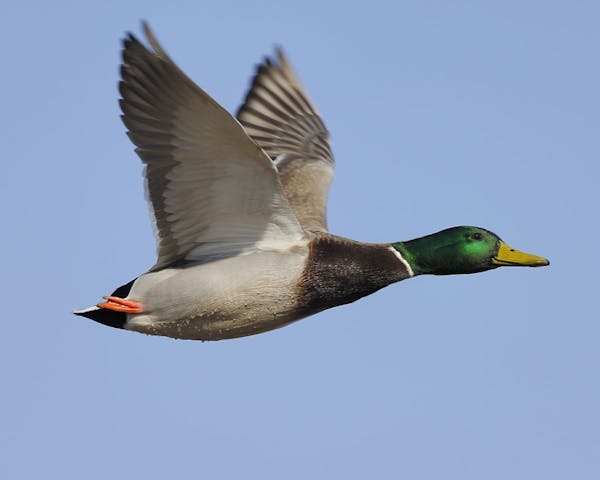Minnesota duck hunters will be well advised to sharpen their eyes when the state's 2011 waterfowl season opens Saturday.
That's because the Department of Natural Resources made significant changes to Minnesota's duck hunting regulations this year:
• It allows shooting a half-hour before sunrise, as opposed to 9 a.m. in recent years and noon before that.
• And the season is opening a week earlier than in recent memory.
Those changes mean duck hunters who shoulder scatterguns at legal shooting time Saturday hoping to kill their six-bird daily limit will in many instances be targeting birds they can't identify by their coloring.
Instead, shapes of ducks, as well as flight and feeding patterns and other factors, will be a hunter's primary determinants when he or she decides which ducks to target -- or not -- in the half-light of early morning.
Because the season is opening a week earlier than usual, some birds will be difficult to identify even after they've been reduced to possession in hand.
Take mallards, the No. 1 bird in Minnesota hunters' bags last year (the 2010 harvest was 138,000, up from 101,000 in 2009).
The law this year allows two hen mallards in a hunter's daily four-mallard limit, up from one hen in recent years.
Many hunters disagreed with the higher hen limit, saying it could put at risk the state's mallard breeding stock over time. But when the decision was made to move legal shooting on the opener to a half-hour before sunrise, and to allow hunting to begin Sept. 24 rather than Oct. 1, the DNR almost had to allow two hen mallards in the daily bag.
If the hen limit had remained at one, some or perhaps many hunters shooting in the dusky predawn would perhaps quickly be over their limits by shooting more than one hen -- whether intentionally or because a hen couldn't be distinguished from an "eclipse" drake (one not yet fully plumed, or colored).
Drake mallards that aren't fully plumed by Saturday (as many won't be) will lack the green heads and other telltale markings that readily distinguish them from hens later in the season. In fact, in September, some drake mallards are difficult, if not impossible, to distinguish from hens even while flying in broad daylight.
Throughout most of the state, Minnesota hunters can be relatively assured that if it's a "big" bird they're targeting on Saturday, there's a good chance it will be a mallard. But it could also be a gadwall or widgeon or perhaps even a pintail, redhead or canvasback -- whose numbers will increase gradually in Minnesota through late October, as the continental migration picks up.
Beware also other ducks
The Minnesota wood duck limit also has been liberalized. Previously, hunters were allowed two daily. This year, they get three.
But because no restriction exists on the number of hen wood ducks that can be killed in a three-bird limit, hunters needn't worry quite so much about exceeding their woodie limit.
Other species whose limits are restricted within Minnesota hunters' six-bird daily bags include pintail, scaup and redhead (two each are allowed daily, hens or drakes) and canvasbacks and black ducks (one each is allowed daily, hen or drake).
In addition to being careful about which "big" ducks are targeted, waterfowlers in northern Minnesota should be aware that while ring-necked ducks (daily limit six) and scaup (daily limit two) are easily distinguished in the hand, they often appear similar in flight and inhabit similar types of landscapes.
Hunters who scout will have an edge identifying ducks on the opener. Such dabbling ducks as mallards, for instance, as well as teal and wood ducks often stay on and near shallow lakes, marshes and wooded ponds. Such divers as scaup, ringnecks, canvasbacks and redheads prefer larger, deeper waters.
A final consideration:
The best and fastest shooting is likely to occur Saturday morning immediately after legal shooting begins.
The temptation for some hunters will be to knock down a bird or two -- or more -- then lie in wait for the next flight.
Two problems with that strategy:
It's illegal not to promptly make an effort to recover ducks that are down. And until you've reduced the fallen ducks to your hand, you won't know for sure what it is you've killed.
You might think you have on the water a pair of drake mallards. But until you know for sure, you shouldn't pull the trigger again. They could be hens.
It's been some years since Minnesota waterfowlers were given a chance to raise their shotguns on the opener a half-hour before sunrise.
The time switch should be an advantage in terms of birds put in the bag on the season's first day. But without careful identification of their quarry, some hunters might find it a disadvantage.
Particularly if a conservation officer is watching from afar, through binoculars.
Dennis Anderson danderson@startribune.com
Anderson: Anglers protesting tough new Mille Lacs rules are wrong

Anderson: Courts, not politicians, should rule on Red Lake, White Earth lands

Anderson: Multimillion windfall gets invasive carp deterrent moving
![A young whitetail deer searches for food as another blanket of snow coats the arrowhead. ] Minnesota -State of Wonders, Arrowhead in Winter BRIAN PETE](https://arc.stimg.co/startribunemedia/WK32UWWY6FKNWJUIYCJ6ZPT4AU.jpg?h=91&w=145&fit=crop&bg=999&crop=faces)
Anderson: In NE Minnesota, DNR staff, habitat and deer all decline


